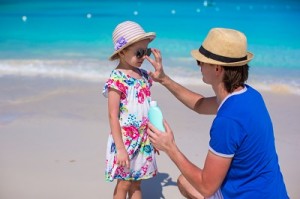By Dr. Patrick McElgunn, Piedmont Plastic Surgery & Dermatology
 Thinking about protection from the sun’s harmful rays should be a part of everyone’s daily routine, regardless of your skin type, age or family history of cancer. Raising children to be “sun smart” starts at home. If children see you limiting your time in the sun, wearing sun-protective clothing and using sunscreen, they will be more likely to then model that behavior, with sun safety becoming a way of life that has lasting positive impact.
Thinking about protection from the sun’s harmful rays should be a part of everyone’s daily routine, regardless of your skin type, age or family history of cancer. Raising children to be “sun smart” starts at home. If children see you limiting your time in the sun, wearing sun-protective clothing and using sunscreen, they will be more likely to then model that behavior, with sun safety becoming a way of life that has lasting positive impact.
Plan around the sun:
- Schedule weekend activities and practices to avoid peak sun intensity between the hours of 10 a.m. and 2 p.m., when the sun’s rays are the strongest and can be the most damaging to the skin.
- Educate your children about the UV Index reading. EPA issues a UV Alert when the level of solar UV radiation reaching your local area is predicted to be unusually intense for the time of year. The UV Alert is a warning, posted by ZIP code, city and state at www.epa.gov/sunwise/uvindex, and offers simple steps that you can take to protect yourself and your family.
- Use extra caution near water, snow and sand because they reflect and intensify the damaging rays of the sun.
Wear sun-protective clothing:
- Look for UV-protective clothing for your children to wear while playing sports or when they are outside. Another option is to have your child wear lightweight long-sleeved shirts or pants and a wide brim hat to shade the face, neck and cover the ears.
- Buy inexpensive sunglasses with UV protection for your child to wear, or have an ultraviolet coating added to the lenses of prescription glasses or contact lenses.
Apply sunscreen properly:
- Generously apply a broad-spectrum, water-resistant sunscreen with a Sun Protection Factor (SPF) of 30 or more to all exposed skin.
- Apply sunscreen approximately 20 minutes before going outside so that it has time to take effect before you go out in the sun. It is easier to apply sunscreen before getting dressed to avoid missing any areas.
- Reapply approximately every two hours, even on cloudy days, and after swimming or sweating.
- The sunscreens that spray directly onto the skin must be rubbed in after spraying. Be careful when applying spray sunscreens outside because much of it may blow away.
Be “sun safe” at school:
- Talk to your child’s teacher or coach about how they incorporate “sun safe” behaviors. Does your child need a note sent with them to apply sunscreen? Find out what you need to do to make sure that your child is protected at school.
- Work to create shaded areas at school for kids playing outside (shade trees, shade structures, temporary shade structures for dugouts and sidelines). Encourage your PTO/PTA to start raising funds if the money isn’t in the budget, or see if your organization would qualify for a shade structure grant from the American Academy of Dermatology.
Let’s say that you encourage these positive behaviors, but still get pushback from your children about sun protection. Explain to them that what they do – and don’t do – NOW will have an impact on them later in life. Sun exposure has a snowball effect, meaning that year after year of suntans and sunburns will cause wrinkles and an increased chance of skin cancer.
So go and grab your kids to have some fun outside, knowing that you’re teaching them how to best protect their skin, and their overall health, in the long run.
Patrick McElgunn, MD, FRCPC, MBA, is a board-certified dermatologist at Piedmont Plastic Surgery & Dermatology‘s Charlotte/Blakeney office. Dr. McElgunn’s area of expertise is general medical and cosmetic dermatology, and he sees patients of all ages. With seven offices in the region, Piedmont Plastic Surgery & Dermatology specializes in dermatology, plastic surgery and Mohs surgery.
This blog was produced in partnership with Charlotte Parent. Click here for the original post and other parenting resources.













